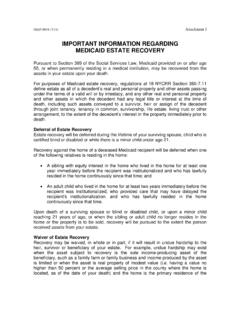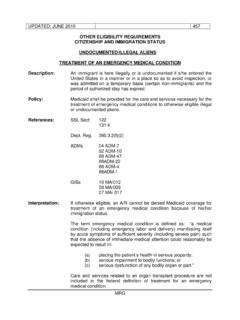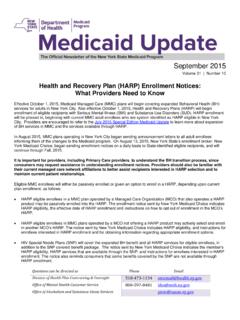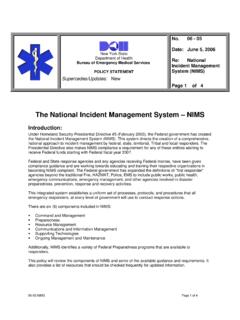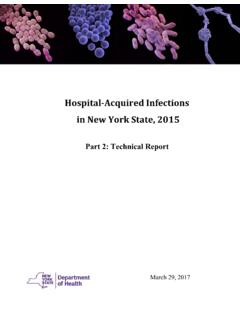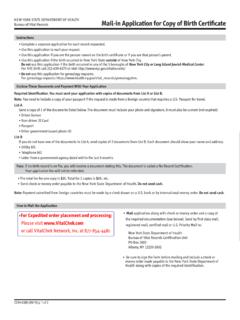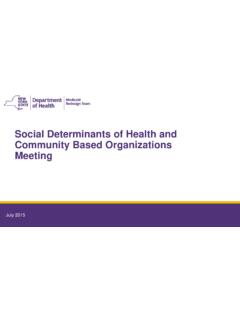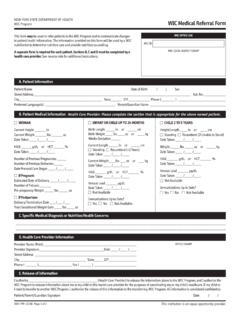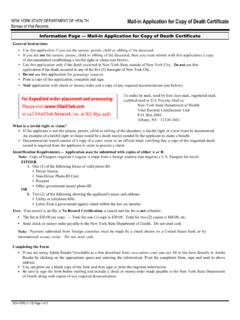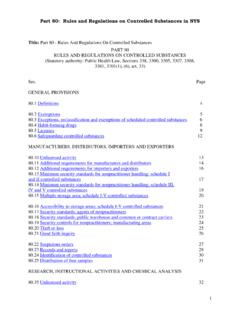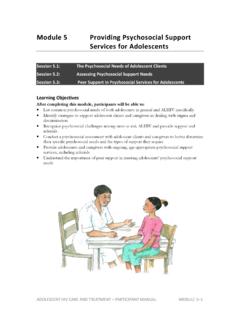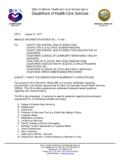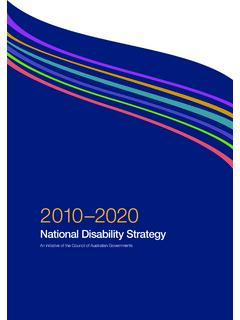Transcription of Children’s Health and Behavioral Health Services ...
1 1 Children s Health and Behavioral Health Services Transformation Medicaid State Plan Children and Family Treatment and support Services Provider Manual for Children s Behavioral Health Early and Periodic Screening and Diagnostic Treatment (EPSDT) Services June 2022 Contents of this manual are subject to change. Any questions or concerns about this document can be sent to 2 Table of Contents Section I: Background .. 3 Section II: Introduction .. 4 Section III: Services .. 6 1. Other Licensed Practitioner .. 6 2. Crisis Intervention .. 12 3. Community Psychiatric Supports and Treatment.
2 18 4. psychosocial Rehabilitation .. 23 5. Family Peer support Services .. 28 6. Youth Peer support .. 36 Section IV: Medical Necessity Criteria .. 45 Section V: Utilization Management .. 59 Section VI: Standards of Care .. 65 Section VII: Appendices .. 76 A. Glossary of Terms .. 76 B. Knowledge Base Skills/ Recommendations .. 82 C. Staffing Guidelines .. 83 D. Cultural Competency and Language Access .. 90 3 I. BACKGROUND New York State (NYS) is pleased to release the Children and Family Treatment and support Services Provider Manual as a guide for the six children s Health and Behavioral Health Medicaid State Plan Services .
3 These Services are an outgrowth of NYS Medicaid Redesign efforts and the valuable direction of the NYS Children s Medicaid Redesign Subcommittee. In collaboration with the Subcommittee, the Office of Mental Health (OMH), Office of Addiction Services and Supports (OASAS), Office of Children and Family Services (OCFS), and the Department of Health (DOH) worked to identify six Services to benefit New York State s children from birth up to 21 years of age. These Children and Family Treatment and support Services are authorized under the Early and Periodic Screening, Diagnosis and Treatment benefits (known commonly as EPSDT).
4 EPSDT is an array of Medicaid benefits for children under 21 years of age, which historically have been focused primarily on children s preventive medical care ( , well baby visits, vaccinations, and screenings at designed ages). This set of Medicaid State Plan Services will enable a greater focus on prevention and early intervention by providing a greater array of available Services and the capacity to intervene earlier in a child/youth s life. The addition of these new Services offers opportunities to better meet the Behavioral Health needs at earlier junctures in a child/youth s life to prevent the onset or progression of Behavioral Health conditions.
5 This expansion of access to and range of these Services will also help to prevent the need for more restrictive and higher intensity Services for children and youth. These following six Services will be available to any child eligible for Medicaid who meets relevant medical necessity criteria: Other Licensed Practitioner Crisis Intervention Community Psychiatric Supports & Treatment psychosocial Rehabilitation Services Family Peer support Services Youth Peer support This array of Services will allow interventions to be delivered in the home and other natural community-based settings where children/youth and their families live.
6 By providing a greater level of flexibility and the capacity for more individualized service delivery, NYS hopes to achieve the guiding force behind the Medicaid benefit redesign, 4 for children and their families to receive the right Services , at the right time and in the right amount . II. INTRODUCTION The development of the six Children and Family Treatment and support Services State Plan Services are intended to better meet children s needs, expand access to clinical treatment Services , and provide a greater array of approaches for rehabilitative interventions. By creating these Services , children and families/caregivers can more readily access the Services regardless of what door they may have entered.
7 Therefore, any child who is Medicaid eligible and is identified as having a Health or Behavioral Health need can access Services with greater flexibility and choice. The implementation of the Children and Family Treatment and support Services are designed to foster and promote the Health and wellness of children/youth and their families/caregivers. As such, these Services are guided by core principles inherent in the children s Behavioral Health system, known to many as the CASSP Core Principles. The CASSP (Child and Adolescent Service System Program) is based on a well-defined set of principles for Behavioral Health Services for children and adolescents with or at risk of developing severe emotional disorders and their families/caregivers.
8 These principles are summarized in six core statements. Child-centered: Services are planned to meet the individual needs of the child, rather than to fit the child into an existing service. Services consider the child's family and community contexts, are developmentally appropriate and child-specific, and build on the strengths of the child and family to meet the mental Health , social and physical needs of the child. NOTE: An integral part of the Children s Medicaid Redesign has been the intent to include the authority for and provision of State recognized Evidenced Based Practice (EBP) models. NYS continues to be committed to the promotion of support of EBP models under the children s transformation and plans to develop a process for agencies to apply and be approved for the provision of recognized EBPs under the EPSDT Children and Family Treatment and support Services State Plan Services , specifically through the Services of Other Licensed Practitioner and Community Psychiatric Supports and Treatment.
9 This process is still under development by the State and will be issued at a later date. More information will be forthcoming. 5 Family-focused: The family is the primary support system for the child and it is important to help empower the family to advocate for themselves. The family participates as a full partner in all stages of the decision-making and treatment planning process including implementation, monitoring and evaluation. A family may include biological, adoptive and foster parents, siblings, grandparents, other relatives, and other adults who are committed to the child. Community-based: Whenever possible, Services are delivered in the child's home community, drawing on formal and informal resources to promote the child's successful participation in the community.
10 Community resources include not only mental Health professionals and provider agencies, but also social, religious, cultural organizations and other natural community support networks. Multi-system: Services are planned in collaboration with all the child-serving systems involved in the child's life. Representatives from all these systems, the child and the family collaborate to define the goals, develop a service plan, identify the necessary resources to implement the plan, provide appropriate support to the child and family, and evaluate progress. Culturally competent: Culture determines our worldview and provides a general design for living and patterns for interpreting reality that are reflected in our behavior.
